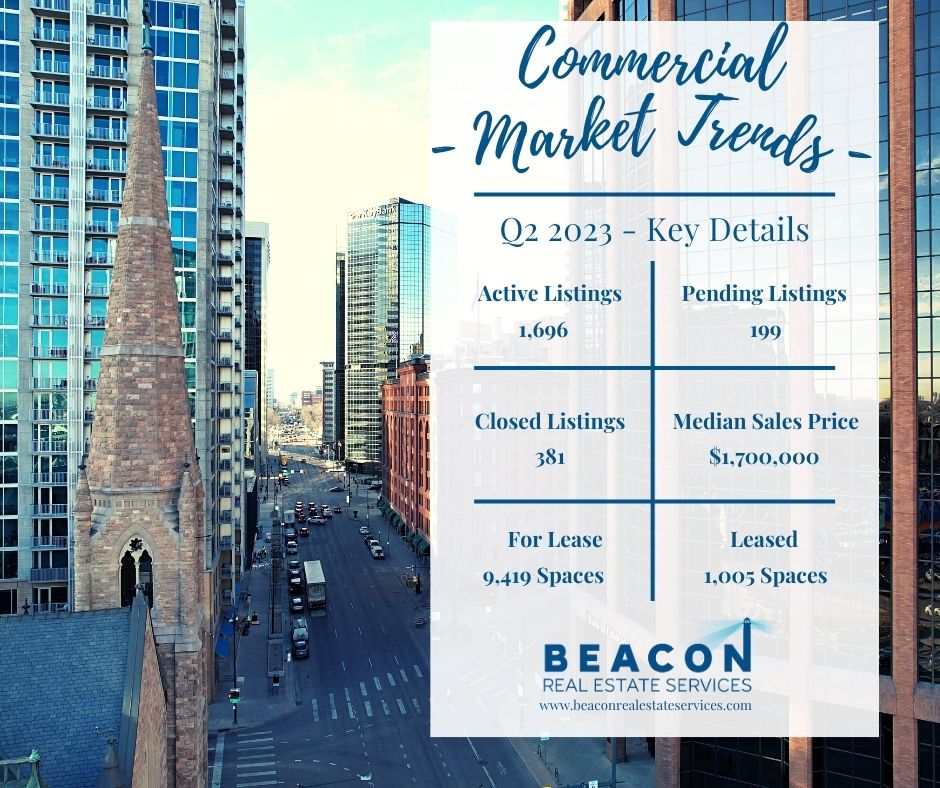
The Denver Commercial Real Estate market saw another slow quarter for sales during Q2. The four major property types saw 269 sales during Q2 2023 compared to 514 sales during Q2 2022 and 433 sales during Q2 2021. Year to date transaction volume for 2023 is down (43.1%) compared to the same period in 2022. This is driven by higher interest rates, tighter lending standards, and economic uncertainty.
The four commercial property types we are tracking are: retail, multi-family, office, and industrial. It is interesting to look at the Commercial Real Estate Market as a whole and the individual property types. Let’s dive into supply, demand, new construction, vacancy rates, and rent growth for Denver Commercial Real Estate.
Below is a summary of key details for each property type.
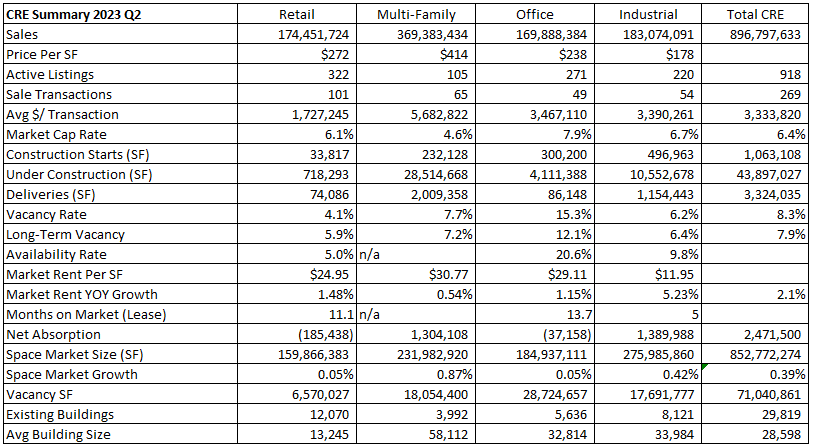
Supply
There are 918 active listings across the four major property types with 322 retail, 105 multi-family, 271 office, and 220 industrial. Throughout 2022, we average 851 commercial listings at the end of each quarter. It is worth noting that the Denver MSA has 29,819 buildings totaling 853M sf of space. Most of the new construction is in multi-family and industrial with retail and office growing by modest amounts. Let’s take a look demand.
Demand
Demand for commercial space is created by people and businesses using the space. When our population is growing, there is an increased demand for housing and shopping. When jobs are created, there is more demand for industrial and office; however, office demand has been decreasing due to the pandemic and remote work.
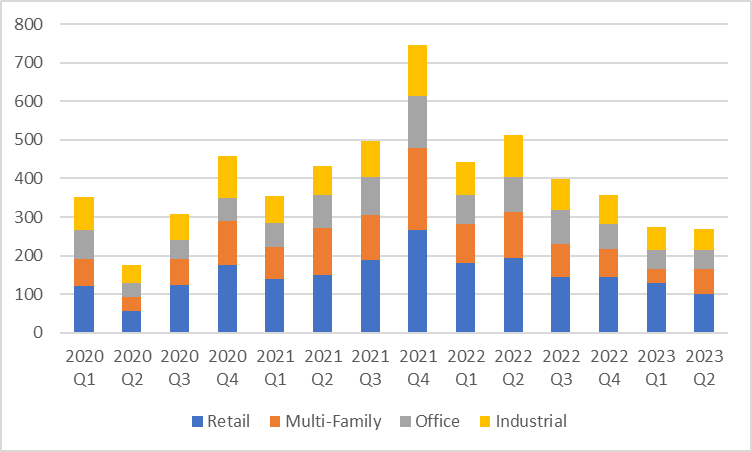
There were 269 closed sales in Q2 2023, which is down from 514closed sales in Q2 2022. This represents a decline of (43.1%). The total dollar volume for retail, multi-family, office, and industrial was $897M in Q2 2023 compared to $4.49B in Q2 2022.
Another gauge for demand is net absorption. Absorption is a gauge of the space tenants need to live or operate their businesses. In Q2 2022, Denver absorbed 4.8M sf, but Q2 2023 only saw 2.47M sf of absorption. Retail and office lost occupancy while mutli-family and industrial gained occupancy. Let's take a look at new construction in the various property types.
New Construction
Developers started construction on 1.06M sf during Q2. This is down dramatically from the 10.26M sf started during Q1. Retail construction starts accounted for 33.8K sf. Multi-family construction starts were 232K sf. Office construction starts were 300K sf, and industrial construction starts accounted for 497k sf.
Another factor to consider is the total sf of space under construction. Retail has 718K sf under construction. Multi-family has 28.5M sf (35,378 units) under construction. This is way too many apartments under construction give the rate of absorption. Office has 4.1M sf under construction, and industrial has 10.6M sf under construction. All together there is 43.9M sf of Commercial Real Estate under construction in Denver.
Developers delivered just over 3.3M sf to the market in Q2 2023. This is moderately lower than Q1 2023 and Q4 2022. Retail delivered 74K sf. Multi-family developers completed 2M sf. Office developers delivered 86K sf. Industrial developers delivered 1.2M sf.
Next, let’s look at vacancy rates to see how much space is not occupied.
Vacancy Rates
A vacancy rate is a metric comparing the amount of unoccupied sf to the total sf of all the buildings in a market. Denver has 71M sf of vacancy for commercial real estate. Although this sounds like a lot, Denver has 852.7M sf of commercial buildings. Therefore, our commercial vacancy rate is 8.3%.
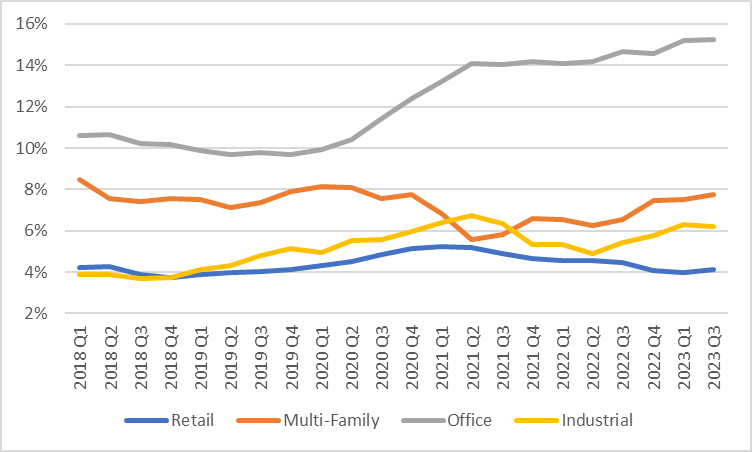
If we are to understand commercial vacancy rates, we need to compare the current vacancy rates to the long-term vacancy rates. Multi-family and industrial properties are very close to their long-term average. Retail is nearly 2% below the long-term average. Office is over 3% higher than the long-term average. Next let’s look at rent growth.
Rent Growth
Rent growth could be lumped into demand but it is interest enough to separate into a new paragraph. Industrial YOY rent growth came in at 5.2% compared to the CPI increase of 5.1% in Q2 2023. All other commercial property types did not keep up with inflation, which erodes some value. Retail rents grew 1.5%, multi-family rents grew 0.5%, and office rents grew 1.1%. Multi-family rent growth has really pulled back since it peaked at 12.4% in Q1 2021 to Q2 2022.
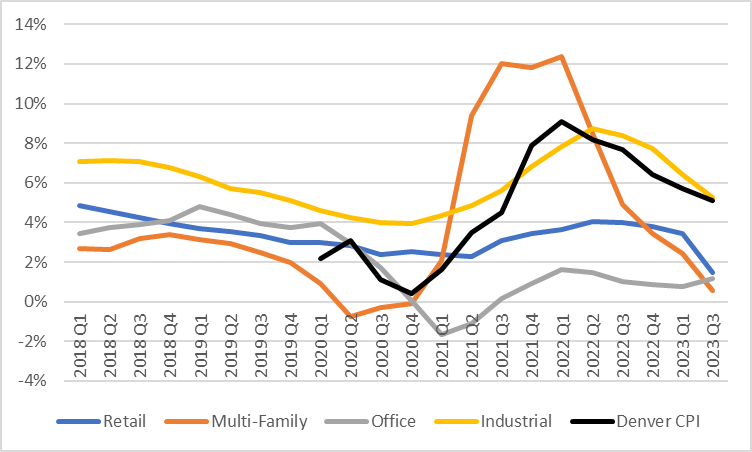
Final Thoughts
In Summary, supply, demand, new construction, vacancy rates, and rent growth are all good key performance indicators for the commercial real estate market in Denver. We have a decent supply of properties for sale. Demand for properties has softened significantly during Q2. Developers are hard at work building multi-family and industrial properties. We would argue they are building too many apartments right now which will push up multi-family vacancy and reduce future rent growth. Vacancy rates are different among the different commercial property types. Office has been consistently higher than the long-term average for several years now. We expect office vacancy to stay higher for the foreseeable future. Lastly, rent growth is stalling for retail, multi-family, and office.
Here is a link to the full presentation for each property type: